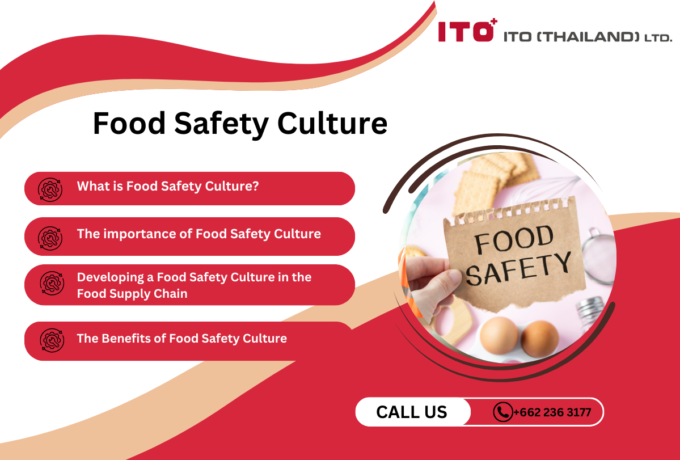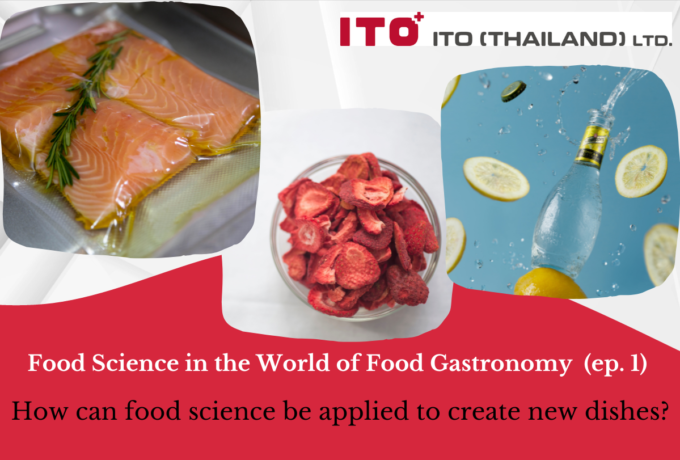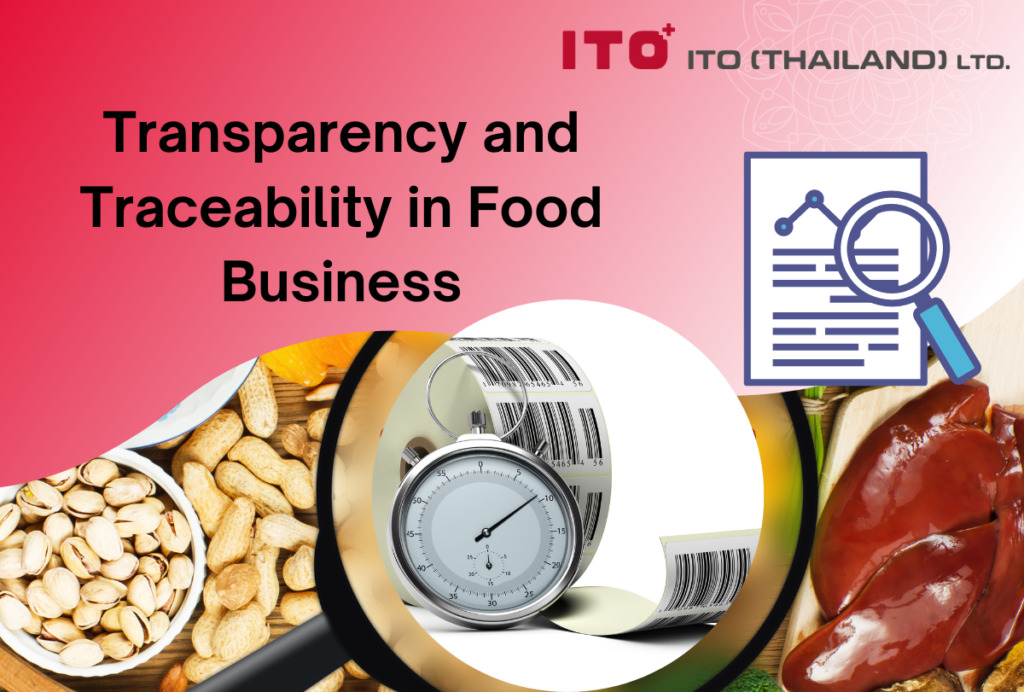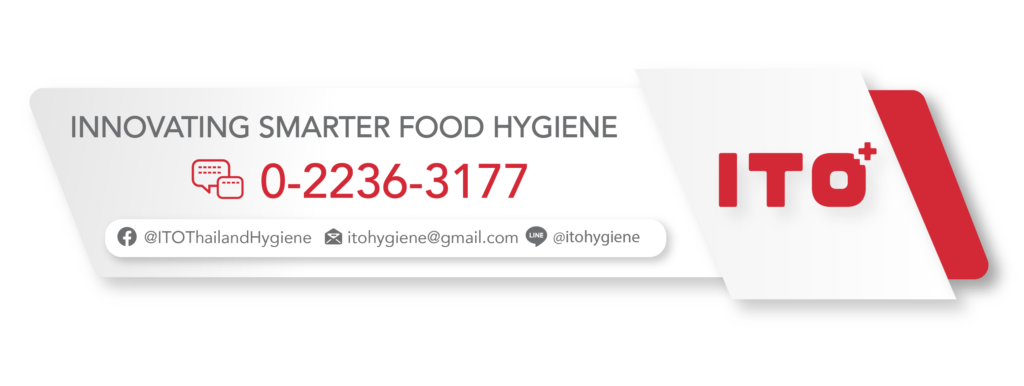ITO Thailand Hygiene Blog
Transparency and Traceability in Food Business
In the previous blog, we discussed how blockchain technology provides safety (traceability and transparency) in the food business, particularly in the case of a foodborne outbreak. Today’s main point of our discussion will be how customers perceive transparency and traceability in the food business.
What is Food Transparency & Food Traceability
Food transparency involves providing detailed and accurate information about food products, allowing consumers to make informed decisions based on their health and environmental impact, and understanding their production practices. Consumers increasingly demand access to complete and easy-to-understand information about the products they buy, and transparency has become an essential factor in building trust and brand loyalty (7).
Food traceability involves documenting and linking food products’ production, processing, distribution chain, and ingredients. For example, in food contamination, efficient product tracing helps to quickly locate the source of the problem, enabling the swift removal of affected products from the market, thus reducing foodborne illnesses (3). Furthermore, a traceability system is crucial for effectively handling food safety issues, such as product recalls, as it allows the identification and isolation of contaminated products quickly and precisely, minimising the impact on consumers and the industry. Therefore, all food businesses, including importers and retailers, must be able to trace their products to ensure food safety (5).
Importance of Food Transparency and Traceability to Food Supply Chain and Food Business
Transparency in the F&B industry leads to accountability, making businesses aware of their unethical or harmful practices. This accountability drives changes and improves results. To achieve transparency, companies need to assess the impact of their products and operations on the environment and make changes to improve processes accordingly. For consumers, transparency allows for informed decisions and builds trust and loyalty. Educating staff about openness, making them visible to customers, and responding to customer demands will create a bond between the restaurant and its customers. The F&B industry can differentiate responsible producers from less responsible ones by being transparent (9). The importance of transparency in the restaurant industry has increased as customers are more concerned about food quality and its impact on their health.
To build trust and loyalty, restaurants should provide information about their ingredients and nutritional value, allergen information, how they operate, and respond honestly to customer inquiries. Additionally, they should be proactive in handling negative situations and consider being vulnerable by sharing personal stories to create a connection with customers. Finally, transparency can increase customer and employee retention and create a better atmosphere for everyone involved (8).
Traceability is crucial in ensuring public health and safety, particularly in emergencies such as food safety or food defence issues. Traceability also plays a vital role in an emergency’s preparedness, response, recovery, and prevention phases. The stakeholders involved in food traceability include government agencies, the food industry, academia, and consumers. The complex and dynamic nature of the food supply chain creates challenges in ensuring food safety and quality. Concerns include foodborne illness, increasing recall incidents, fraudulent activities, and contamination risks due to long and complex supply chains. Traceability helps reduce the impact of these issues, including economic loss, consumer distrust, and increased regulatory demands. Different stakeholders have different reasons for valuing traceability, including risk management, productivity, brand confidence, and market access. However, traceability is critical to all stakeholders regardless of their specific reasons. (4)
Trends and Consumers’ Expectations
Food transparency is a trend where consumers want to know where food comes from, and they are concerned about food safety and origins and are more vocal about it on social media. Therefore, retailers who can use in-depth data, consumer trends, and new insights to foster more innovation in this area will be able to develop their strategies to win (2). Edelman’s report found that trust in governments globally has declined, with a quarter of countries needing to trust their governments to provide necessities. Consumers are now looking to businesses to fill the void left by governments, with CEOs expected to speak up on societal issues and hold themselves accountable to stakeholders. The pandemic has increased the urgency to address systemic problems such as poverty, climate change, fake news, and racism. Edelman identified five system gaps that the food and beverage industry should address: an innovation gap, an inclusion gap, an information gap, an incentive gap, and an investment gap. Leaders must demonstrate the behaviours they want to be reflected throughout the company in the food safety culture (6).
The new generation of consumers demands transparency from the food brands they buy from, focusing on products that benefit themselves, others, and the planet. Consumers are looking to brands, not the government, to keep them informed about their food. More is needed for brands to have good recognition; consumers want to feel like they have made the right choice for themselves and the environment. Providing transparency may come at a cost, but brands willing to do so will capture a significant and growing portion of the market. Conversely, brands that only meet the changing demands of consumers risk losing more than a third of their clients (1).
References
1.Cather, A. (2019). The Bottom Line or Consumer Demand–Which is Driving Food Transparency? Retrieved April 16, 2023, from https://www.nycfoodpolicy.org/the-bottom-line-or-consumer-demand-which-is-driving-food-transparency/
2.DuBois, C. (2023). The Rise of Food Transparency. Retrieved April 16, 2023, from https://www.iriworldwide.com/en-us/insights/blog/the-nbsp;rise-of-food-transparency
3.(2022). Tracking and Tracing of Food. Retrieved April 16, 2023, from https://www.fda.gov/food/new-era-smarter-food-safety/tracking-and-tracing-food
4.Fisher, W. (2015). The Importance of Food Traceability. Retrieved April 16, 2023, from https://www.food-safety.com/articles/3926-the-importance-of-food-traceability
5.(2017). Food traceability. Retrieved April 16, 2023, from https://www.foodstandards.gov.au/industry/safetystandards/traceability/pages/default.aspx
6.Grylls, B. (2021). The future of trust and transparency in the food supply chain. Retrieved April 16, 2023, from https://www.newfoodmagazine.com/article/158504/the-new-era-of-transparency/
7.Huang, J. (2022). What is the transparency of food? Retrieved April 16, 2023, from https://www.globalfoodconsumers.org/news/what-is-the-transparency-of-food/
8.Media, Z. (2021). 5 Ways to Increase Your Restaurant’s Transparency with Customers. Retrieved April 16, 2023, from https://onedine.com/2021/01/29/5-ways-to-increase-your-restaurants-transparency-with-customers/
9.Senese, R. (2023). Food transparency is a recipe for business success. Retrieved April 16, 2023, from https://english.alarabiya.net/views/2023/03/16/Food-transparency-is-a-recipe-for-business-success-
Related Post
-

Food Safety Culture
Food safety culture plays a crucial role in safeguarding the company's reputation, ensuring the well-being of its employees, and providing a safe experience for its customers.
-

New food source safety issues
What are safety issues worth knowing for trendy new food sources like plant-based and insect-based proteins?
-

British Retail Consortium (BRC) Standard
Food safety management systems play a vital role in ensuring the production and distribution of safe and high-quality food products to consumers. With the global food supply chain becoming increasingly complex, food businesses must implement effective systems prioritising safety, quality, and compliance with industry standards. A food safety management system encompasses a set of procedures, processes, and controls designed to identify, prevent, and manage potential hazards at every stage of the food production and supply process. This proactive approach not only safeguards consumers' health but also protects the reputation and credibility of food companies in an ever more competitive market.
-

Food Science in the World of Food Gastronomy (Part 1)
How can food science be applied to create new dishes?
-

FSSC 22000
Food manufacturers must ensure food safety standards and processes. FSSC 22000 is an official certification program for Food Safety Management Systems (FSMS) recognised by the Global Food Safety Initiative (GFSI). This certification scheme offers a set of guidelines and procedures to ensure uniformity, openness, and safety across your entire supply chain. It applies to all companies operating within the food and beverage industry, ranging from farmers to retailers. By fulfilling the necessary criteria and obtaining FSSC 22000 certification, it is demonstrated that the required standards for food quality and implementing effective processes to manage and mitigate risks associated with food fraud, foodborne illnesses, expensive recalls, and other external threats are met.
-

Food Safety Aspects of Artificial Sweeteners
Artificial sweeteners, also known as sugar substitutes, non-nutritive sweeteners, or high-intensity sweeteners, are artificially produced compounds utilised in place of sucrose (table sugar) to add sweetness to food and drinks. Due to their significantly higher sweetness than regular sugar, only a fraction of artificial sweeteners (200 to 20,000 times less) is required to achieve an equivalent level of sweetness. Since the caloric contribution of these sweeteners, when used in such small quantities, is insignificant, they are often referred to as non-nutritive (4).










